Abstract
Rubinstein-Taybi Syndrome (RTS) also called as Broad Thumb-Hallux syndrome is a genetic disorder characterized by facial dysmorphism, growth retardation, mental deficiency, eye abnormalities, kidney and heart ailments, orodental problems and obesity. RTS is a rare congenital syndrome that occurs in 1/125,000–300,000 individuals. Mutations in two genes - CREBBP and EP300 have been identified to cause the syndrome. Extraoral features reveal distinctive facial appearance with a broad forehead, hypertelorism, broad nasal bridge, and beaked nose. Intraoral features aresmall mouth opening, talon cusps, missing permanent teeth, high arched narrow palate, malocclusion and associated dental caries with gingival disease. This case report describes the etiology and clinical features of the Rubinstein-Taybi Syndrome which are important for the dental clinicians for the management of such cases.
Keywords: Broad thumb-hallux syndrome; Mutations; Mental deficiency
Introduction
Rubinstein-Taybi Syndrome (RTS) was initially described by Michail et al. in 1957 [1]. In 1963, Rubenstein and Taybi reported on seven cases, which included a group of congenital anomalies consisting of short, broad thumbs and great toes, psychomotor retardation, highly arched palates, and histories of recurrent respiratory infections and particular facial abnormalities [1].
The incidence of the syndrome has been estimated to be in 1/125,000–300,000 individuals [2]. There is an equal male and female incidence [2-4]. RTS has autosomal dominant mode of inheritance with mutations in the genes encoding the Cyclic-AMP-Regulated Enhancer Binding Protein (CREBBP) and the E1A-binding protein p300 (EP300) contributed to the development of RTS [5]. Therefore, genetic tests are useful for the diagnosis of RTS, although most RTS cases are currently diagnosed based on clinical features [6].
Case Report
A 9-year-old girl reported to the Department of Pedodontics and Preventive Dentistry with a complaint of dental caries and bleeding of gingiva. Patient had delayed physical and mental development. She is the second child of a consanguineous married couple. There was no significant family history. Patient was diagnosed with Rubinstein- Taybi Syndrome at the age of five year.
Extra oral findings of patients were hypertelorism, slanting palpebral fissures, beaked nose with deviated nasal septum and small mouth (Figure 1&2). Intra-oral findings were high-arched palate, significantly small mouth opening and malocclusion (Figures 3a and 3b). The patient had multiple grossly carious lesions and gingivitis with profuse bleeding on probing (Figures 3a,3b&Figure 4). OPG of patient showed oligodontia with missing 31,32,33,41,42,43,12,22 (Figure 5).
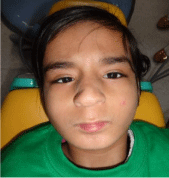
Figure 1: Facial characteristics include hypertelorism, slanting palpebral
fissures and beaked nose with deviated nasal septum.
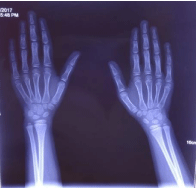
Figure 2: Broad thumbs, broad terminal phalanges were absent.

Figure 3: (a) Maxillary arch shows high arched palate with multiple grossly
carious lesions.
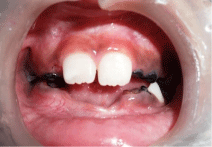
Figure 3: (b) Small mouth opening showing malocclusion with oligodontia.
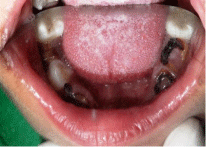
Figure 4: Lower molar teeth also had several grossly carious lesions and
lower anteriors were missing.
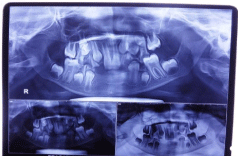
Figure 5: OPG showing oligodontia with missing 31,32,33,41,42,43,12,22.
Preventive dental health strategies with parental counseling were initiated in this patient. Extraction of all grossly decayed teeth followed by restorations andextensive oral health care was planned for the patient. While treatment, behavior modification techniques were used like Tell-Show-Do (TSD), physical restraints with the positive reinforcement and involvement of mother.
Discussion
Rubinstein-Taybi Syndrome is a rare multiple congenital anomaly syndrome. It is caused by either a microdeletion at 16p13.3 or mutations in the CREB-Binding Protein (CREBBP or CBP) or EP300 gene (at 22q13) [7]. These two genes show strong homology and encode Histone Acetyltransferases (HATs), which are transcriptional co-activators involved in many signaling pathways. Loss of HAT activity is sufficient to account for the phenomena seen in Rubinstein–Taybi patients. Although some mutations found in CREBBP are translocations, inversions and large deletions, most are point mutations or small deletions and insertions. Mutations in EP300 are comparatively rare. Extensive screening of patients has revealed mutations in CREBBP and EP300 in around 50% of cases [8-12]. Dentists along with the medical team need to differentiate this syndrome with other conditions like Down’s syndrome, Floating- Harbor syndrome, Pfeiffer and Saethre-Chotzen syndromes.
Clinically, this syndrome is characterized by decreased growth, mental retardation, broad mediated deviated thumbs with big toes. Patients also exhibits some craniofacial abnormalities like downward slanted palpebral fissures, microcephaly, posterior rotated ears, hypertelorism, long eyelashes, pouting upper lip and beaked nose with the columella protruding below alaenase. Other clinical features include cryptorchidism, gastrointestinal tract abnormalities, recurrent respiratory tract infections [13].Congenital anomalies of cardiovascular system are also described such as ventricular septal defect, patent ductusarteriosus, coarctation and stenosis of the aorta and pulmonic stenosis [14]. This patient presented several clinical manifestations of RTS. She did not presented any cardiac,gastrointestinal tract or respiratory abnormalities, which are frequently found in 24–38% of children with RTS [15].
Dental abnormalities occur in 67% of individuals with RTS and can include limited mouth opening, a pouting lower lip, retro/ micrognathia, a high arched and narrow palate, cleft palate and rarely a cleft upper lip. Hypodontia or oligodontia, retained deciduous teeth, talon cusps and enamel hypoplasia are common occurrence in RTS. An increased rate of caries and periodontal disease has been reported in these patients (15% to 36%) because of their poor oral hygiene and inability due to mental retardation which was similar to our patient [16,17]. Malposition and crowded teeth are present in 62% of patients [18]. In this patient, reduced mouth opening, oligodontia, and high arched palate were present. Generalized heavy calculus and plaque deposition was presentdue to very poor oral hygiene with generalized gingivitis and localized periodontitis. Upper and lower primary teeth had grossly carious lesions.
As the mental development is affected in RTS patients, so the level of cooperation is less among them compared to the normal ones. Many patients with RTSmay require dental treatment to be carried out under sedation or general anesthesia, depending, upon their level of cooperation [19]. Anesthesia has to be considered under strict medical supervision in a hospital setup. The treatment in RTS patients demands palliative care and preventive management strategies. This should be followed by various other oral rehabilitation treatment procedures like restorations, extractions, preventive and interceptive orthodontic management etc. Genetic counseling may be considered as a part of counseling to parents.
Conclusion
The orodental complications of RTS are important but usually remain neglected aspects of the disorder. It has become apparent that the multifaceted orodental problems necessitate a team approach towards dental management which may require interventions under anesthesia. Multidisciplinary collaboration is crucial for effective management and for the well-being of the affected person. This case report adds more literature in the path of diagnosing and increasing the knowledge of various clinical features and prevalence of this syndrome.
References
- Michail J, Matsoukas J, Theodorou S. Arched, clubbed thumb in strong abduction-extension & other concomitant symptoms. Revue de chirurgieorth ope´diqueetre´paratrice de l’appareilmoteur. 1957; 43: 142-146.
- Rubinstein JH, Taybi H. Broad thumbs and toes and facial ormalities: a possible mental retardation syndrome. Am J Dis Child. 1963; 105: 588-608.
- Freitas NM, Imbronito AV, La Scala CS, Lotufo RF, Pustiglioni FE. Periodontal disease in a Rubinstein-Taybi syndrome patient: case report. Int J Paediatr Dent. 2006; 16: 292-296.
- Altintas F, Cakmakkaya S. Anesthetic management of a child with Rubinstein- Taybi syndrome. PediatrAnesth. 2004; 14: 610-611.
- Milani D, Manzoni FM, Pezzani L, Ajmone P, Gervasini C, Menni F, et al. Rubinstein-Taybi syndrome: clinical features, genetic basis, diagnosis, and management. Ital J Pediatr. 2015; 41: 4.
- Roelfsema JH, White SJ, Ariyürek Y, Bartholdi D, Niedrist D, Papadia F, et al. Genetic heterogeneity in Rubinstein-Taybi syndrome: mutations in both the CBP and EP300 genes cause disease. Am J Hum Genet. 2005; 76: 572–580.
- Bartok WR, Reed WB, Fish C. Rubinstein-Taybisyndrome. Cutis. 1968; 4: 1350-1353.
- Petrij F, Dauwerse HG, Blough RI, Giles RH, van der Smagt JJ, Wallerstein R, et al. Diagnostic analysis of the Rubinstein-Taybi syndrome: five cosmids should be used for microdeletion detection and low number of protein truncating mutations. J Med Genet. 2000; 37: 168-176.
- Petrif F, Giles RH, Dauwerse HG, Saris JJ, Hennekam RC, Masuno M, et al. Rubinstein-Taybi syndrome caused by mutations in the transcriptional coactivator CBP. Nature. 1995; 376: 348-351.
- Imaizumi K, Kuroki Y. Rubinstein–Taybi syndrome with de novo reciprocal translocation t(2;16)(p13.3;p13.3). Am J Med Genet. 1991: 38; 636-639.
- Tommerup N, Van Der Hagen CB, Heiberg A. Tentative assignment of a locus for Rubinstein Taybi syndrome to 16p13. 3 by a de novo reciprocal translocation, t (7; 16)(q34; p13. 3). Am J Med Genet. 1992; 44: 237-241.
- Lacombe D, Saura R, Taine L, Battin J. Confirmation of assignment of a locus for Rubinstein–Taybi syndrome gene to 16p13.3. Am J Med Genet.1992: 44; 126-128.
- Segura JJ, Jimenez-Rubio A. Talon cusp affecting permanent maxillary lateral incisors in 2 family members. Oral Surg Oral Pathol Oral RadiolEndod. 1999; 88: 90-92.
- Stevens CA, Bhakta MG. Cardiac abnormalities in the Rubinstein-Taybi syndrome. Am J Med Genet A. 1995; 59: 346–348.
- Wiley S, Swayne S, Rubinstein JH, Lanphear NE, Stevens CA. Rubinstein- Taybi syndrome medical guidelines. Am J Med Genet. 2003; 119A: 101-110.
- Hsiung S. Rubinstein–Taybi syndrome (broad thumb – hallux syndrome). Dermatol Online J. 2006; 10: 2-7.
- Miller RW, Rubinstein JH. Tumors in Rubinstein-Taybi syndrome. Am J Med Genet. 1995; 56: 112-115.
- Davidovich E, Eimerl D, Peretz B. Dental treatment of a child with Rubinstein- Taybi syndrome. Pediatr Dent. 2005; 27: 385-388.
- Gorlin RJ, Cohen MM, Hennekam RC. Proportionate short stature syndrome: Syndromes of the head and neck. 4thedition. Oxford University Press: USA. 2001; 382-387.
